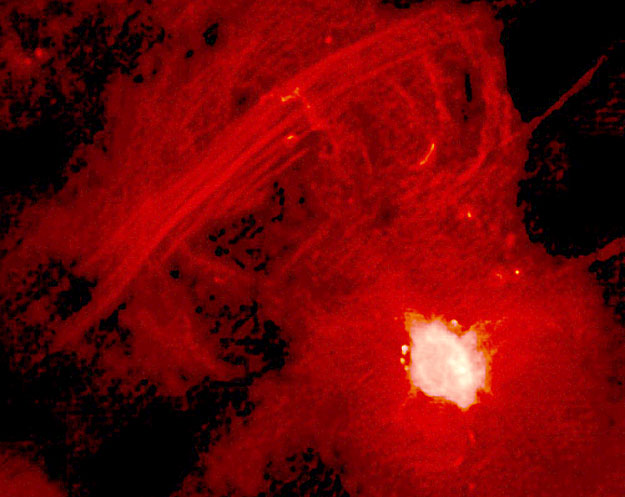
home •
about •
essential guide •
picture of the day •
thunderblogs •
news •
multimedia •
predictions •
products •
get involved •
contact
picture of the day archive subject index
Credit: Farhad Yusef-Zadeh et al. (Northwestern), VLA, NRAO
Apr 27, 2007
Galactic Currents or Collisions?Although there is only one image, the mainstream view and the plasma view see entirely different objects.
The Astronomy Picture of the Day described this image this way:
“What causes this unusual structure near the center of our Galaxy? The long parallel rays slanting across the top of the above radio image are known collectively as the Galactic Center Radio Arc and jut straight out from the Galactic plane. The Radio Arc is connected to the Galactic center by strange curving filaments known as the Arches. The bright radio structure at the bottom right likely surrounds a black hole at the Galactic center and is known as Sagittarius A*. One origin hypothesis holds that the Radio Arc and the Arches have their geometry because they contain hot plasma flowing along lines of constant magnetic field. Recent images from the Chandra X-ray Observatory appear to show this plasma colliding with a nearby cloud of cold gas.”
What’s unusual for orthodox astronomy is familiar for plasma astronomy. What orthodoxy sees as “long parallel rays”, plasma astronomy sees as spiraling pairs of magnetic-field-aligned Birkeland currents. The “strange curving filaments” in the conventional view are, in the plasma view, more Birkeland currents feeding electrical power into the galactic center. The popular theory-derived “black hole” is, with plasma, a scaled-up version of an empirically laboratory-demonstrated plasmoid. Although convention gives token acknowledgement to plasma in the next-to-last sentence, the final sentence belies its ignorance of how plasma actually behaves: Field-aligned plasma flows are better known as Birkeland currents. They generate x-rays electrically, not from the heat of collisions.
![]()
home •
thunderblogs •
forum •
picture of the day •
resources •
team •
updates •
contact us
EXECUTIVE EDITORS:
David Talbott, Wallace Thornhill
MANAGING EDITORS:
Steve Smith, Mel Acheson
CONTRIBUTING EDITORS: Michael Armstrong, Dwardu Cardona,
Ev Cochrane,
C.J. Ransom, Don Scott, Rens van der Sluijs, Ian Tresman
WEBMASTER: Brian Talbott
Copyright 2007: thunderbolts.info
